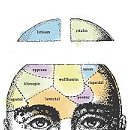From Disability Visibility Project: “CBT as a modality is based around gaslighting. It’s all about telling a patient that the world is safe, bad feelings are temporary, and that pain (emotional or physical) is a ‘faulty or unhelpful’ distortion of thinking. That’s literally in CBT’s definition on the APA website. But how do they determine that someone’s thinking is ‘faulty or unhelpful’? From the first session, therapists told me my way of thinking was the problem, not the medical conditions I couldn’t control or things like systemic injustices, financial struggles, trauma, and discrimination. And that’s a big problem with CBT. When therapists look at patients through the lens of patients’ thinking being faulty or distorted, not the larger issues impacting their lives, therapists miss those larger issues and the patient is invalidated and harmed even further.
[Maybe some people find CBT helpful] but what happens in CBT when your thinking is not actually distorted? When you’re someone who has chronic pain, chronic illness, and disability? Someone dealing with systemic and societal issues that are very real and harmful? Someone dealing with trauma, PTSD, or currently being abused? Someone living in a global pandemic that’s disabling and killing millions of people? I believe CBT is built to be dismissive and invalidating. And that’s what was done to me for so long that even I wondered at times if maybe I was causing my own pain, that if I ‘fixed’ my thinking and could stop being anxious, my pain would get better. But two decades of therapy only made me feel more lost and confused, and the pain only got worse. I lost so much time focusing on therapy that I could have been seeing the right specialists and doing preventative treatments that might have stopped my illnesses from progressing the way they have.
. . . CBT is based on the premise that any patient coming into therapy is experiencing distorted, ‘faulty,’ ‘catastrophizing’ thinking. CBT therapists are trained to convince patients that they’re overreacting and that they’ll feel better when they realize they’re overreacting. They believe patients will realize that the world is actually safe (or at least safer than they think it is) and that emotions are based on unjustified fears and misinterpretations. Except that isn’t true. I can’t say I know anyone that’s true for. And it very much blames the victim, the patient. It tells them the problem is their way of processing pain and trauma, not whatever is actually causing it. With chronic pain, the problem can be physical, worsened by the neglect of the medical system. I can’t wish that away. I can’t convince myself I’m not in pain that exists and is being neglected. It’s not true. And it’s harmful to tell me that’s how I’ll get better when it’s not.
Also, CBT practitioners seem to work off an assumption that patients will feel better if they refocus their attention to distractions. I can’t tell you how many therapists told me to just go out, make new friends, join a club, even giving me worksheets to schedule and report those kinds of activities. None of that helped me. First of all, it was hard to go out and make friends when I was living in chronic pain. It also felt so dismissive to be told the solution was just to distract myself and pretend everything was fine when I had real, physical pain and trauma going on that wasn’t being properly addressed.”

***
Back to Around the Web











